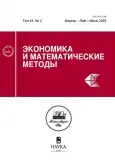Regional Effects of Fiscal Policy: Analysis with Spatial Vector Autoregressive Models
- Авторлар: Demyanenko A.V.1
-
Мекемелер:
- National Research University Higher School of Economics
- Шығарылым: Том 61, № 2 (2025)
- Беттер: 90-103
- Бөлім: Regional problems
- URL: https://journal-vniispk.ru/0424-7388/article/view/312196
- DOI: https://doi.org/10.31857/S0424738825020078
- ID: 312196
Аннотация
Авторлар туралы
A. Demyanenko
National Research University Higher School of Economics
Email: ademyanenko@hse.ru
Moscow, Russia
Әдебиет тізімі
- Власов С. А., Дерюгина Е. Б. (2018). Фискальные мультипликаторы в России // Журнал Новой экономической ассоциации. № 2 (38). С. 104–119. [Vlasov S. A., Deryugina E. B. (2018). Fiscal multipliers in Russia. Journal of the New Economic Association, 2 (38), 104–119 (in Russian).]
- Вотинов А. И., Станкевич И. П. (2017). VAR-подход к оценке эффективности мер фискального стимулирования экономики // Финансовый журнал. Т. 40. № 6. С. 64–74. [Votinov A. I., Stankevich I. P. (2017). VAR approach to efficiency evaluation of fiscal economy encouragement measures. Financial Journal, 6 (40), 64–74 (in Russian).]
- Демидова О. А. (2021). Методы пространственной эконометрики и оценка эффективности государственных программ // Прикладная эконометрика. № 64. С. 107–134. [Demidova O. A. (2021). Methods of spatial econometrics and evaluation of government programs effectiveness. Applied Econometrics, 64, 107–134 (in Russian).]
- Демидова О. А., Каяшева Е. В., Демьяненко А. В. (2021). Государственные расходы на здравоохранение и экономический рост в России: региональный аспект // Пространственная экономика. T. 17. № 1. С. 97–122. [Demidova O. A., Kayasheva E. V., Demyanenko A. V. (2021). Government spending on healthcare and economic growth in Russia: A regional aspect. Spatial Economics, 17 (1), 97–122 (in Russian).]
- Зяблицкий И. Е. (2020). Оценка фискальных мультипликаторов в российской экономике // Экономический журнал Высшей школы экономики. Т. 24. № 2. С. 268–294. [Zyablitskiy I. E. (2020). Estimating fiscal multipliers in Russian economy. HSE Economic Journal, 24 (2), 268–294 (in Russian).]
- Каменских М. В., Иванова Н. Ю. (2011). Эффективность государственных расходов в России // Экономическая политика. № 1. С. 176–192. [Kamenskih M. V., Ivanova N.Yu. (2011). Efficiency of government expenditures in Russia. Economic Policy, 1, 176–192 (in Russian).]
- Регионы России. Социально-экономические показатели (2005–2022). М.: Росстат. [Regions of Russia. Socio-economic indicators (2005–2022). Moscow: Rosstat (in Russian).]
- Armingeon K. (2012). The politics of fiscal responses to the crisis of 2008–2009. Governance, 25, 4, 543–565.
- Auerbach A. J., Gorodnichenko Y., Murphy D. (2019). Local fiscal multipliers and fiscal spillovers in the United States (No. 25457). National Bureau of Economic Research. doi: 10.3386/w25457
- Batini N., Eyraud L., Forni L., Weber A. (2014). Fiscal multipliers: Size, determinants, and use in macroeconomic projections. International Monetary Fund.
- Blanchard O., Perotti R. (2002). An empirical characterization of the dynamic effects of changes in government spending and taxes on output. The Quarterly Journal of Economics, 117, 4, 1329–1368.
- Blanchard O. J., Watson M. W. (1986). Are business cycles all alike? In: The American business cycle: Continuity and change. Chicago: University of Chicago Press.
- Boone C., Dube A., Kaplan E. (2014). The political economy of discretionary spending: Evidence from the American Recovery and Reinvestment Act. Brookings Papers on Economic Activity, 375–428.
- Brandeis C., Lambert D. M. (2014). Projecting county pulpwood production with historical production and macro-economic variables. Journal of Forest Economics, 20, 3, 305–315.
- Čapek J., Crespo Cuaresma J. (2020). We just estimated twenty million fiscal multipliers. Oxford Bulletin of Economics and Statistics, 82, 3, 483–502.
- Coenen G., Erceg C. J., Freedman C., Furceri D., Kumhof M., Lalonde R. et al. (2012). Effects of fiscal stimulus in structural models. American Economic Journal: Macroeconomics, 4, 1, 22–68.
- Corsetti G., Meier A., Müller G. J. (2012). What determines government spending multipliers. Economic Policy, 27, 72, 521–565.
- Devarajan S., Swaroop V., Zou H. F. (1996). The composition of public expenditure and economic growth. Journal of Monetary Economics, 37, 2, 313–344.
- Dupor B., Guerrero R. (2017). Local and aggregate fiscal policy multipliers. Journal of Monetary Economics, 92, 16–30.
- Forni M., Gambetti L. (2016). Government spending shocks in open economy VARs. Journal of International Economics, 99, 68–84.
- Giannini M., Fiorelli C., Martini B. (2022). Ageing in the labour market: A spatial VAR approach. Spatial Economic Analysis, 17, 2, 538–556.
- Hagedorn M., Manovskii I., Mitman K. (2019). The fiscal multiplier (No. 25571). National Bureau of Economic Research. doi: 10.3386/w25571
- Harris R. D.F., Tzavalis E. (1999). Inference for unit roots in dynamic panels where the time dimension is fixed. Journal of Econometrics, 91, 2, 201–226.
- Im K. S., Pesaran M. H., Shin Y. (2003). Testing for unit roots in heterogeneous panels. Journal of Econometrics, 115, 1, 53–74.
- Kuethe T. H., Pede V. O. (2011). Regional housing price cycles: A spatio-temporal analysis using US state-level data. Regional Studies, 45, 5, 563–574.
- Lee L. F., Yu J. (2010). Estimation of spatial autoregressive panel data models with fixed effects. Journal of Econometrics, 154, 2, 165–185.
- Nakamura E., Steinsson J. (2014). Fiscal stimulus in a monetary union: Evidence from US regions. American Economic Review, 104, 3, 753–792.
- Raga S. (2022). Fiscal multipliers: A review of fiscal stimulus options and impact on developing countries. Ottawa: IDRC. Available at: https://set.odi.org/wp-content/uploads/2022/01/Fiscal-multipliers-review.pdf
- Ramey V. A. (2011). Identifying government spending shocks: It’s all in the timing. The Quarterly Journal of Economics, 126, 1, 1–50.
- Ramey V. A. (2016). Handbook of macroeconomics. Amsterdam: Elsevier.
- Romer C. D., Romer D. H. (2010). The macroeconomic effects of tax changes: Estimates based on a new measure of fiscal shocks. American Economic Review, 100, 3, 763–801.
- Yu J., Jong R. de, Lee L. F. (2008). Quasi-maximum likelihood estimators for spatial dynamic panel data with fixed effects when both n and T are large. Journal of Econometrics, 146, 1, 118–134.









